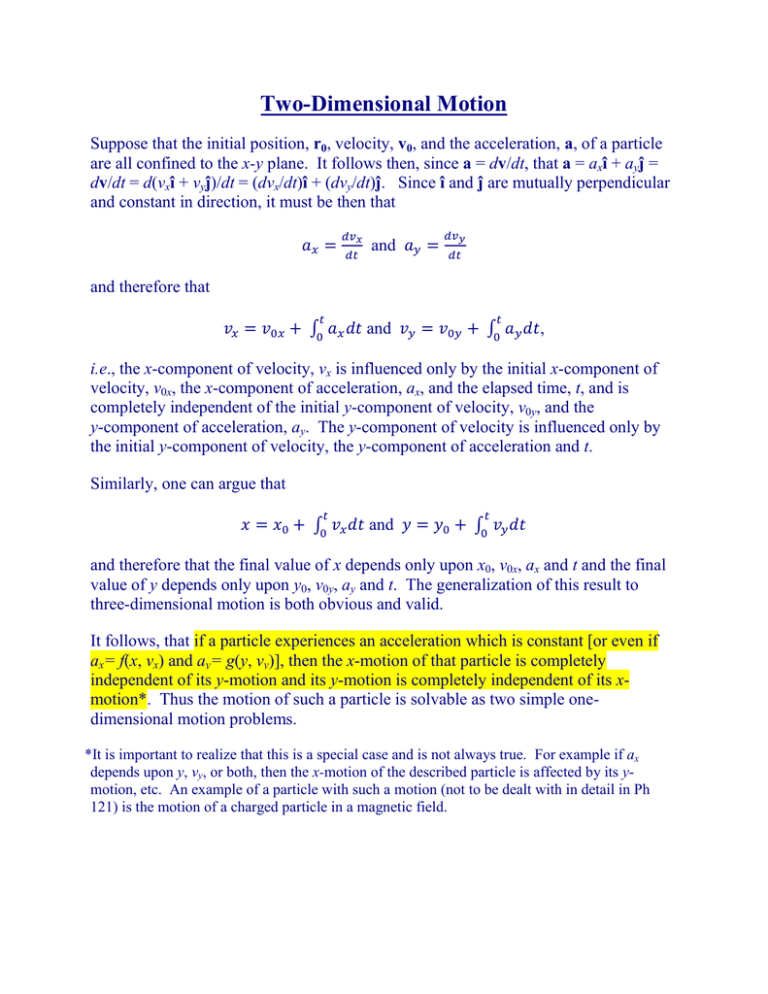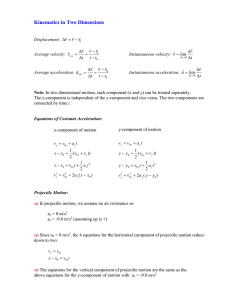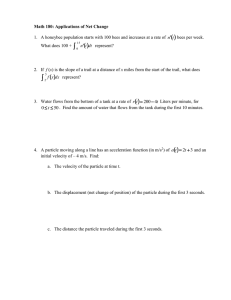Two-Dimensional Motion - BYU Physics and Astronomy
advertisement

Two-Dimensional Motion Suppose that the initial position, r0, velocity, v0, and the acceleration, a, of a particle are all confined to the x-y plane. It follows then, since a = dv/dt, that a = axî + ayĵ = dv/dt = d(vxî + vyĵ)/dt = (dvx/dt)î + (dvy/dt)ĵ. Since î and ĵ are mutually perpendicular and constant in direction, it must be then that 𝑎𝑥 = 𝑑𝑣𝑥 𝑑𝑡 and 𝑎𝑦 = 𝑑𝑣𝑦 𝑑𝑡 and therefore that 𝑡 𝑡 𝑣𝑥 = 𝑣0𝑥 + ∫0 𝑎𝑥 𝑑𝑡 and 𝑣𝑦 = 𝑣0𝑦 + ∫0 𝑎𝑦 𝑑𝑡, i.e., the x-component of velocity, vx is influenced only by the initial x-component of velocity, v0x, the x-component of acceleration, ax, and the elapsed time, t, and is completely independent of the initial y-component of velocity, v0y, and the y-component of acceleration, ay. The y-component of velocity is influenced only by the initial y-component of velocity, the y-component of acceleration and t. Similarly, one can argue that 𝑡 𝑡 𝑥 = 𝑥0 + ∫0 𝑣𝑥 𝑑𝑡 and 𝑦 = 𝑦0 + ∫0 𝑣𝑦 𝑑𝑡 and therefore that the final value of x depends only upon x0, v0x, ax and t and the final value of y depends only upon y0, v0y, ay and t. The generalization of this result to three-dimensional motion is both obvious and valid. It follows, that if a particle experiences an acceleration which is constant [or even if ax= f(x, vx) and ay= g(y, vy)], then the x-motion of that particle is completely independent of its y-motion and its y-motion is completely independent of its xmotion*. Thus the motion of such a particle is solvable as two simple onedimensional motion problems. *It is important to realize that this is a special case and is not always true. For example if ax depends upon y, vy, or both, then the x-motion of the described particle is affected by its ymotion, etc. An example of a particle with such a motion (not to be dealt with in detail in Ph 121) is the motion of a charged particle in a magnetic field.







